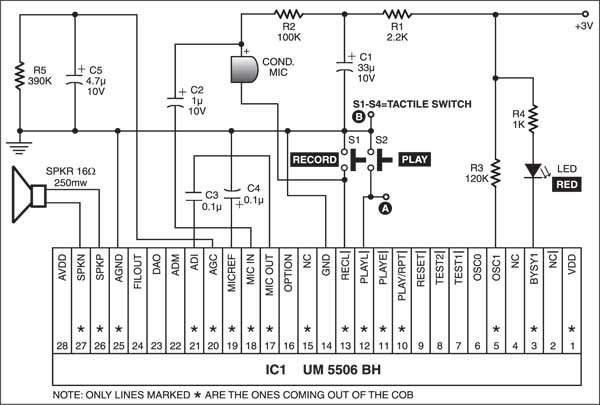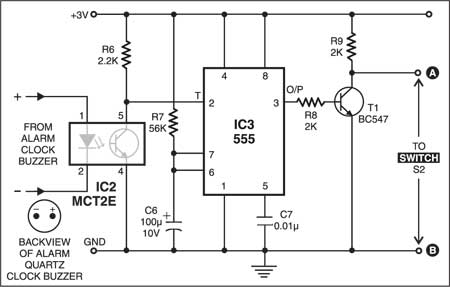 This alarm plays your prerecorded voice message. It is built around the readily available quartz clock. Take the buzzer out of the quartz clock and connect its positive terminal to pin 1 and negative terminal to pin 2 of optocoupler IC MCT2E (IC2). Pin 4 of IC2 is grounded and pin 5 is connected to trigger pin 2 of monostable multivibrator IC 555 (IC3) as shown in Fig. 2.
This alarm plays your prerecorded voice message. It is built around the readily available quartz clock. Take the buzzer out of the quartz clock and connect its positive terminal to pin 1 and negative terminal to pin 2 of optocoupler IC MCT2E (IC2). Pin 4 of IC2 is grounded and pin 5 is connected to trigger pin 2 of monostable multivibrator IC 555 (IC3) as shown in Fig. 2.

Fig. 1 shows the circuit for recording your voice message. When you press switch S2, it plays the meassage. The control circuit shown in Fig. 2 avoids the need for pressing switch S2 and thereby sounding the voice alarm automatically at the preset time.
Connect points A and B of the recording circuit to the corresponding points A and B of the control circuit. After making the connections, press record switch S1 to record your 6-second voice message through condenser microphone. Set the desired alarm time in quartz clock. At the time of alarm, buzzer terminals provide voltage to the internal LED of optocoupler IC2. This results in conduction of internal transistor of IC2, and its collector voltage at pin 5 drops to trigger IC3. The output of IC3 goes high for approximately 6 seconds. During this period, the prerecorded message is heard continuously. The message repeats every 6 seconds. The sound is loud enough in a room.

The circuit operates off 3 volts and it can be easily fitted in a small box and fixed on the back side of the alarm quartz clock.
The voice control circuit is generally made up of 555 Timer IC. The circuit is shown above which generally includes MCT2E IC, 555 IC, two 2k resistors, 2.2k resistor, 56k resistor, 2 capacitors and one BC547 transistor.
This circuit is very useful for home and office use, if you want to give any message to your guests or clients when it is locked.







